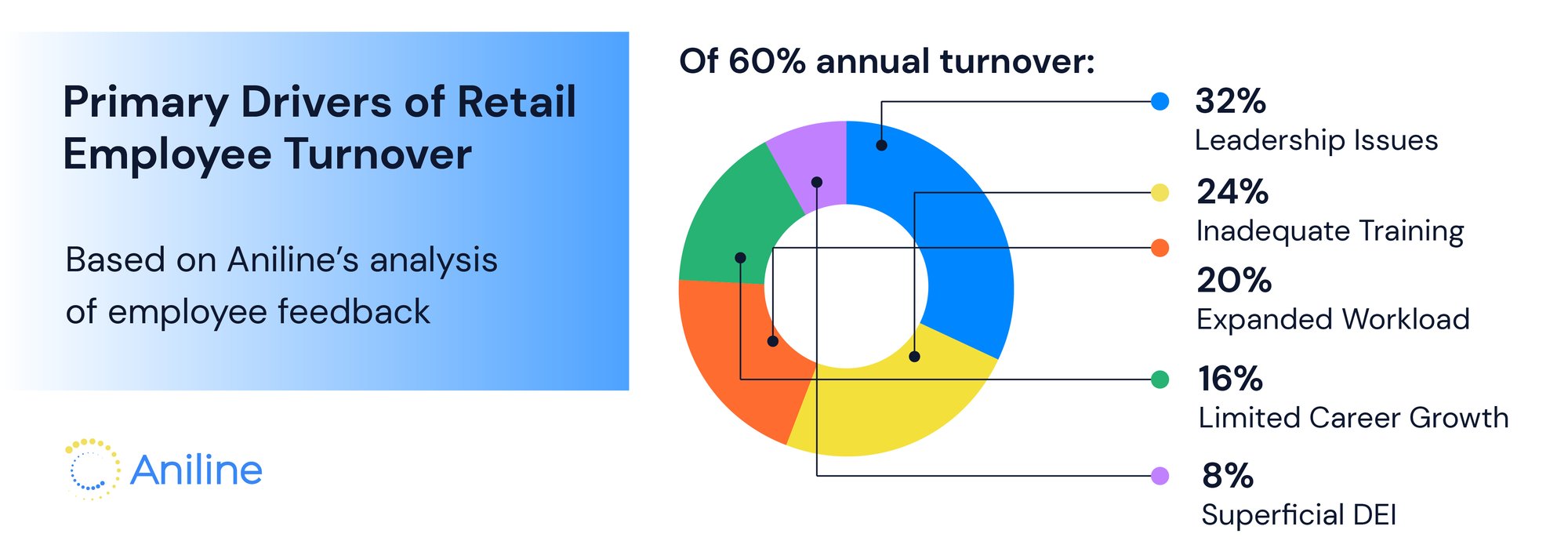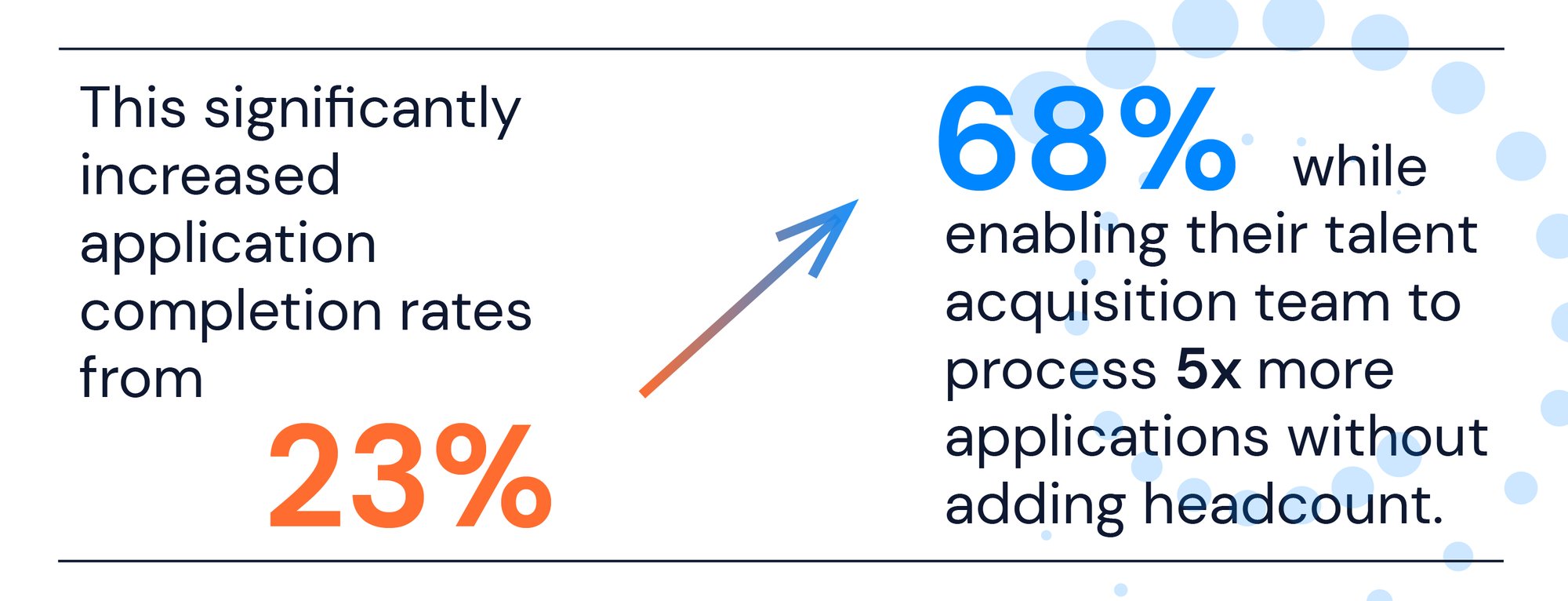Beyond the Great Resignation: Solving Retail's $50+ Billion Turnover Crisis
Employee turnover is costing the retail industry over $50 billion annually, with frontline turnover exceeding 60% and climbing 19% since the pandemic. Retailers are essentially replacing their entire workforce every two years, creating a crisis that directly impacts customer experience, operational efficiency, and profitability.
The Alarming Reality of Retail Turnover
Aniline’s recent comprehensive analysis of millions of employee perceptions reveals that 50% of frontline retail employees are considering leaving their jobs soon, with nearly half planning to exit the industry entirely. Even more concerning, 63% of frontline managers—the backbone of store operations—are thinking about quitting.
Five key drivers are fueling this exodus:
- Leadership Disconnect: The retail industry scores a dismal 24/100 for leadership effectiveness (bottom 6th percentile). Store associates consistently report a profound disconnect between corporate strategy and frontline reality, with one employee lamenting: "Management doesn't support employees at all. When we needed help on the floor or at registers, management would hide in the office."
- Chronic Understaffing: "Expected to do the job of 3 people with no additional compensation" is a sentiment expressed in 72% of negative reviews. This perpetual understaffing creates a vicious cycle—overworked employees quit, creating more work for those who remain.
- Inadequate Training: While career development scores appear average (55/100), onboarding effectiveness scores are significantly lower at 38/100 (13th percentile). An alarming 68% of employees who left within 90 days cited inadequate training as a primary factor.
- Superficial Diversity Efforts: With retailers scoring in the bottom 3rd percentile for DE&I initiatives (26/100), there's a stark gap between public commitments and workplace reality. Only 23% of retail employees believe diversity initiatives translate to meaningful change.
- Limited Growth Opportunities: Professional development scores at just 46/100 (17th percentile) reflect severely limited advancement paths. Despite claims of prioritizing internal advancement, only 22% of management positions are filled through internal promotion.

The Financial Case for Action
Most retailers vastly underestimate turnover costs. Conservative estimates place the cost of replacing a frontline retail employee at 50-60% of their annual salary, with management positions costing 100-150% to replace.
The business case for improvement is compelling:
- Leading retailers using AI-powered recruitment have reduced time-to-fill by 25-35% while improving quality-of-hire metrics by 22%.
- Enhanced retention programs focusing on better onboarding and manager training have increased employee tenure by 19%, directly improving same-store sales (+4.2%) and customer satisfaction (+7.6%).
- Advanced recruitment solutions have reduced cost-per-hire by 37% while simultaneously improving candidate quality.
Data-Driven Solutions for Retention Success
Forward-thinking retailers are leveraging five strategic approaches to transform their turnover crisis.
- AI-Powered Matching: Smart technologies that evaluate candidates against 120+ data points are reducing time-to-fill by up to 30% while improving 90-day retention by 18%.
- Precision at Scale: Modern recruitment platforms are transforming high-volume hiring while maintaining quality. One national pharmacy chain increased application completion rates from 23% to 68% while enabling their talent team to process 5x more applications without adding headcount.
- Leadership Development: A regional grocery chain developed a "leadership prediction profile" based on their most successful store managers, then implemented targeted development programs. Stores with academy-trained managers saw 22% higher employee satisfaction and 14% lower turnover
- Consistent Experiences: Standardized yet flexible hiring processes address the inconsistent practices highlighted in employee feedback. One retailer's implementation of consistent practices reduced time-to-hire deviation between stores by 47% and improved candidate satisfaction scores from 3.2/5 to 4.4/5.
- Analytics-Driven Planning: Predictive analytics can forecast hiring needs 90 days in advance and identify employee flight risk based on behavioral indicators. Stores using advanced analytics experienced 23% higher retention and 17% fewer emergency hiring situations.

Path Forward: Actionable Steps to Take Today
Don't just acknowledge the turnover crisis—take these specific actions to transform it into competitive advantage:
- Audit Your Management Effectiveness: Implement 360-degree feedback for store managers and tie 30-40% of their bonuses to retention metrics and employee satisfaction scores. Stores with effective managers experience 104% lower turnover and 24% higher conversion rates.
- Reinvent Your Onboarding: Develop a structured 90-day onboarding program that includes not just training but regular check-ins and milestone celebrations. For every $1,000 invested here, you'll save $3,200 in turnover costs.
- Create Visibility into Career Paths: Implement transparent promotion criteria and develop a formal internal recruitment program that prioritizes current employees. Retailers with clear career progression fill 40% more management positions internally.
- Implement a Recognition System: Train managers to provide specific, weekly recognition to high performers. Employees receiving regular recognition are 5.2x more likely to stay beyond 18 months, yet only 14% of retail managers do this consistently.
- Use Predictive Analytics: Deploy systems that identify flight risk 45-60 days before resignations typically occur. Focus particularly on schedule consistency, which has 2.8x more impact on retention than hourly wage increases.
The most successful retailers are seeing 3% higher comparative store sales by addressing these issues systematically. Your turnover crisis is solvable, and tackling it will deliver measurable financial returns.
What specific retention initiative will you implement in the next 30 days to begin transforming your turnover challenge into competitive advantage?
.png?width=2000&height=1264&name=Retail%20Turnover%20Roadmap%20(1).png)
.png?width=4334&height=1355&name=Logo%20with%20name_Blue%2BYellow%20(1).png)